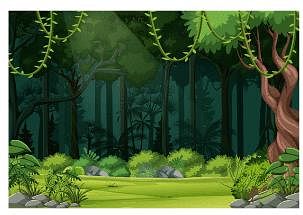Class 1 Exam > Class 1 Questions > What is a noun for a large, green area with t...
Start Learning for Free
What is a noun for a large, green area with trees and grass?
- a)Ocean
- b)Desert
- c)Forest
- d)Mountain
Correct answer is option 'C'. Can you explain this answer?
Verified Answer
What is a noun for a large, green area with trees and grass?a)Oceanb)D...
"Forest" is a noun that names a large area covered predominantly with trees and undergrowth. Forests are vital for maintaining Earth's ecology.


Most Upvoted Answer
What is a noun for a large, green area with trees and grass?a)Oceanb)D...
Forest
A forest is a noun used to describe a large, green area with trees and grass.
Characteristics of a Forest:
- A forest typically consists of a dense growth of trees, plants, and underbrush.
- It provides habitat for a variety of wildlife species.
- Forests play a crucial role in maintaining biodiversity and regulating the climate.
Types of Forests:
- Tropical Forests: Found near the equator, these forests are characterized by high levels of biodiversity.
- Temperate Forests: Located in regions with distinct seasons, these forests have a mix of deciduous and coniferous trees.
- Coniferous Forests: Dominated by coniferous trees like pine, spruce, and fir, these forests are found in colder regions.
Importance of Forests:
- Oxygen Production: Trees in forests absorb carbon dioxide and release oxygen through photosynthesis.
- Water Regulation: Forests play a crucial role in regulating the water cycle and preventing soil erosion.
- Biodiversity: Forests are home to a wide range of plant and animal species, contributing to overall ecosystem health.
In conclusion, a forest is a vital ecosystem that provides numerous benefits to the environment and wildlife.
A forest is a noun used to describe a large, green area with trees and grass.
Characteristics of a Forest:
- A forest typically consists of a dense growth of trees, plants, and underbrush.
- It provides habitat for a variety of wildlife species.
- Forests play a crucial role in maintaining biodiversity and regulating the climate.
Types of Forests:
- Tropical Forests: Found near the equator, these forests are characterized by high levels of biodiversity.
- Temperate Forests: Located in regions with distinct seasons, these forests have a mix of deciduous and coniferous trees.
- Coniferous Forests: Dominated by coniferous trees like pine, spruce, and fir, these forests are found in colder regions.
Importance of Forests:
- Oxygen Production: Trees in forests absorb carbon dioxide and release oxygen through photosynthesis.
- Water Regulation: Forests play a crucial role in regulating the water cycle and preventing soil erosion.
- Biodiversity: Forests are home to a wide range of plant and animal species, contributing to overall ecosystem health.
In conclusion, a forest is a vital ecosystem that provides numerous benefits to the environment and wildlife.

|
Explore Courses for Class 1 exam
|

|
Similar Class 1 Doubts
What is a noun for a large, green area with trees and grass?a)Oceanb)Desertc)Forestd)MountainCorrect answer is option 'C'. Can you explain this answer?
Question Description
What is a noun for a large, green area with trees and grass?a)Oceanb)Desertc)Forestd)MountainCorrect answer is option 'C'. Can you explain this answer? for Class 1 2025 is part of Class 1 preparation. The Question and answers have been prepared according to the Class 1 exam syllabus. Information about What is a noun for a large, green area with trees and grass?a)Oceanb)Desertc)Forestd)MountainCorrect answer is option 'C'. Can you explain this answer? covers all topics & solutions for Class 1 2025 Exam. Find important definitions, questions, meanings, examples, exercises and tests below for What is a noun for a large, green area with trees and grass?a)Oceanb)Desertc)Forestd)MountainCorrect answer is option 'C'. Can you explain this answer?.
What is a noun for a large, green area with trees and grass?a)Oceanb)Desertc)Forestd)MountainCorrect answer is option 'C'. Can you explain this answer? for Class 1 2025 is part of Class 1 preparation. The Question and answers have been prepared according to the Class 1 exam syllabus. Information about What is a noun for a large, green area with trees and grass?a)Oceanb)Desertc)Forestd)MountainCorrect answer is option 'C'. Can you explain this answer? covers all topics & solutions for Class 1 2025 Exam. Find important definitions, questions, meanings, examples, exercises and tests below for What is a noun for a large, green area with trees and grass?a)Oceanb)Desertc)Forestd)MountainCorrect answer is option 'C'. Can you explain this answer?.
Solutions for What is a noun for a large, green area with trees and grass?a)Oceanb)Desertc)Forestd)MountainCorrect answer is option 'C'. Can you explain this answer? in English & in Hindi are available as part of our courses for Class 1.
Download more important topics, notes, lectures and mock test series for Class 1 Exam by signing up for free.
Here you can find the meaning of What is a noun for a large, green area with trees and grass?a)Oceanb)Desertc)Forestd)MountainCorrect answer is option 'C'. Can you explain this answer? defined & explained in the simplest way possible. Besides giving the explanation of
What is a noun for a large, green area with trees and grass?a)Oceanb)Desertc)Forestd)MountainCorrect answer is option 'C'. Can you explain this answer?, a detailed solution for What is a noun for a large, green area with trees and grass?a)Oceanb)Desertc)Forestd)MountainCorrect answer is option 'C'. Can you explain this answer? has been provided alongside types of What is a noun for a large, green area with trees and grass?a)Oceanb)Desertc)Forestd)MountainCorrect answer is option 'C'. Can you explain this answer? theory, EduRev gives you an
ample number of questions to practice What is a noun for a large, green area with trees and grass?a)Oceanb)Desertc)Forestd)MountainCorrect answer is option 'C'. Can you explain this answer? tests, examples and also practice Class 1 tests.

|
Explore Courses for Class 1 exam
|

|
Signup for Free!
Signup to see your scores go up within 7 days! Learn & Practice with 1000+ FREE Notes, Videos & Tests.


























